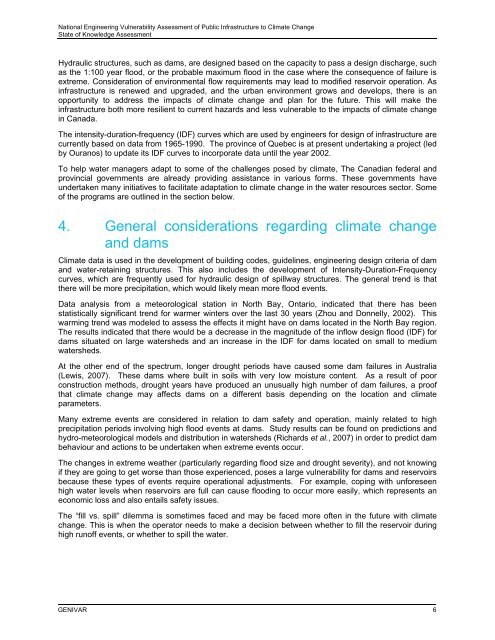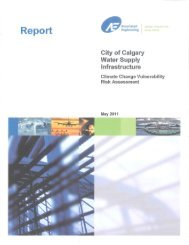Final Report - Vulnerability Committee
Final Report - Vulnerability Committee
Final Report - Vulnerability Committee
You also want an ePaper? Increase the reach of your titles
YUMPU automatically turns print PDFs into web optimized ePapers that Google loves.
National Engineering <strong>Vulnerability</strong> Assessment of Public Infrastructure to Climate ChangeState of Knowledge AssessmentHydraulic structures, such as dams, are designed based on the capacity to pass a design discharge, suchas the 1:100 year flood, or the probable maximum flood in the case where the consequence of failure isextreme. Consideration of environmental flow requirements may lead to modified reservoir operation. Asinfrastructure is renewed and upgraded, and the urban environment grows and develops, there is anopportunity to address the impacts of climate change and plan for the future. This will make theinfrastructure both more resilient to current hazards and less vulnerable to the impacts of climate changein Canada.The intensity-duration-frequency (IDF) curves which are used by engineers for design of infrastructure arecurrently based on data from 1965-1990. The province of Quebec is at present undertaking a project (ledby Ouranos) to update its IDF curves to incorporate data until the year 2002.To help water managers adapt to some of the challenges posed by climate, The Canadian federal andprovincial governments are already providing assistance in various forms. These governments haveundertaken many initiatives to facilitate adaptation to climate change in the water resources sector. Someof the programs are outlined in the section below.4. General considerations regarding climate changeand damsClimate data is used in the development of building codes, guidelines, engineering design criteria of damand water-retaining structures. This also includes the development of Intensity-Duration-Frequencycurves, which are frequently used for hydraulic design of spillway structures. The general trend is thatthere will be more precipitation, which would likely mean more flood events.Data analysis from a meteorological station in North Bay, Ontario, indicated that there has beenstatistically significant trend for warmer winters over the last 30 years (Zhou and Donnelly, 2002). Thiswarming trend was modeled to assess the effects it might have on dams located in the North Bay region.The results indicated that there would be a decrease in the magnitude of the inflow design flood (IDF) fordams situated on large watersheds and an increase in the IDF for dams located on small to mediumwatersheds.At the other end of the spectrum, longer drought periods have caused some dam failures in Australia(Lewis, 2007). These dams where built in soils with very low moisture content. As a result of poorconstruction methods, drought years have produced an unusually high number of dam failures, a proofthat climate change may affects dams on a different basis depending on the location and climateparameters.Many extreme events are considered in relation to dam safety and operation, mainly related to highprecipitation periods involving high flood events at dams. Study results can be found on predictions andhydro-meteorological models and distribution in watersheds (Richards et al., 2007) in order to predict dambehaviour and actions to be undertaken when extreme events occur.The changes in extreme weather (particularly regarding flood size and drought severity), and not knowingif they are going to get worse than those experienced, poses a large vulnerability for dams and reservoirsbecause these types of events require operational adjustments. For example, coping with unforeseenhigh water levels when reservoirs are full can cause flooding to occur more easily, which represents aneconomic loss and also entails safety issues.The “fill vs. spill” dilemma is sometimes faced and may be faced more often in the future with climatechange. This is when the operator needs to make a decision between whether to fill the reservoir duringhigh runoff events, or whether to spill the water.GENIVAR 6








